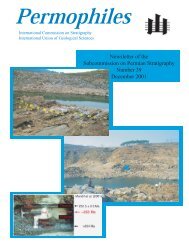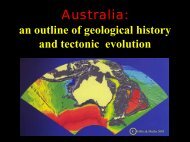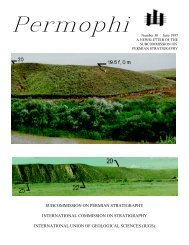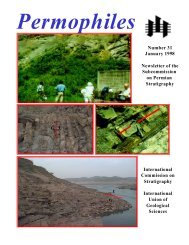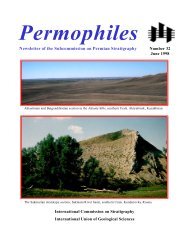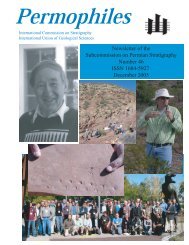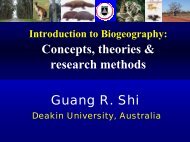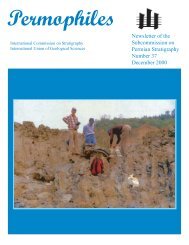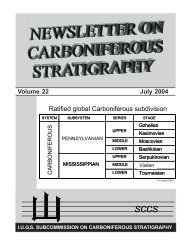Newsletter of the Subcommission on Permian Stratigraphy Number ...
Newsletter of the Subcommission on Permian Stratigraphy Number ...
Newsletter of the Subcommission on Permian Stratigraphy Number ...
You also want an ePaper? Increase the reach of your titles
YUMPU automatically turns print PDFs into web optimized ePapers that Google loves.
Permophiles Issue #38 2001been published. In additi<strong>on</strong>, intrinsic and extrinsic c<strong>on</strong>trol mechanisms<strong>on</strong> reef formati<strong>on</strong> have been investigated. The most importantresults are summarized below.I. Tax<strong>on</strong>omic affinities, diversity, and guild structureAnalysis <str<strong>on</strong>g>of</str<strong>on</strong>g> large acetate sheet tracings, close-up photos, andpolished quadrat surfaces at four localities near <str<strong>on</strong>g>the</str<strong>on</strong>g> base <str<strong>on</strong>g>of</str<strong>on</strong>g> <str<strong>on</strong>g>the</str<strong>on</strong>g>Guadalupe Mountains escarpment indicate that <str<strong>on</strong>g>the</str<strong>on</strong>g> Upper CapitanLimest<strong>on</strong>e reef was built by 34 species <str<strong>on</strong>g>of</str<strong>on</strong>g> “calcareous” sp<strong>on</strong>gesand demosp<strong>on</strong>ges, 9 bryozoans, <str<strong>on</strong>g>the</str<strong>on</strong>g> richth<str<strong>on</strong>g>of</str<strong>on</strong>g>eniid brachiopodSestropoma cribriferum Cooper and Grant, 1969, <str<strong>on</strong>g>the</str<strong>on</strong>g> phylloid algaEug<strong>on</strong>ophyllum sp., 4 Problematica, and microbes. Demosp<strong>on</strong>ge“sphinctozoans” and inozoid calcareous sp<strong>on</strong>ges are major c<strong>on</strong>stituents<str<strong>on</strong>g>of</str<strong>on</strong>g> <str<strong>on</strong>g>the</str<strong>on</strong>g> Middle <strong>Permian</strong> upper Capitan Limest<strong>on</strong>e. Thefauna appears diverse <strong>on</strong> local scale, but compared to <str<strong>on</strong>g>the</str<strong>on</strong>g> diversity<str<strong>on</strong>g>of</str<strong>on</strong>g> assemblages <str<strong>on</strong>g>of</str<strong>on</strong>g> similar age in Tunisia and in Sou<str<strong>on</strong>g>the</str<strong>on</strong>g>rn China,<str<strong>on</strong>g>the</str<strong>on</strong>g> assemblage is species poor. Gigantosp<strong>on</strong>gia disc<str<strong>on</strong>g>of</str<strong>on</strong>g>orma Rigbyand Senowbari-Daryan 1996, a discoidal inozoid calcareous sp<strong>on</strong>geat least 2.5 m in diameter, is <str<strong>on</strong>g>the</str<strong>on</strong>g> largest described <strong>Permian</strong> sp<strong>on</strong>ge.In additi<strong>on</strong> to previously described reef-builders <str<strong>on</strong>g>of</str<strong>on</strong>g> o<str<strong>on</strong>g>the</str<strong>on</strong>g>r tax<strong>on</strong>omicaffiliati<strong>on</strong>, Lercaritubus problematicus Flügel, Senowbari-Daryan, and Di Stefano, 1990, an organism <str<strong>on</strong>g>of</str<strong>on</strong>g> unknown affinity,was identified in <str<strong>on</strong>g>the</str<strong>on</strong>g> Capitan Limest<strong>on</strong>e for <str<strong>on</strong>g>the</str<strong>on</strong>g> first time. A reevaluati<strong>on</strong><str<strong>on</strong>g>of</str<strong>on</strong>g> <str<strong>on</strong>g>the</str<strong>on</strong>g> Guild C<strong>on</strong>cept highlights <str<strong>on</strong>g>the</str<strong>on</strong>g> validity <str<strong>on</strong>g>of</str<strong>on</strong>g> <str<strong>on</strong>g>the</str<strong>on</strong>g> functi<strong>on</strong>alroles <str<strong>on</strong>g>of</str<strong>on</strong>g> <str<strong>on</strong>g>the</str<strong>on</strong>g> C<strong>on</strong>structor, Binder, and Baffler Guilds for reefc<strong>on</strong>structi<strong>on</strong>. Although members <str<strong>on</strong>g>of</str<strong>on</strong>g> <str<strong>on</strong>g>the</str<strong>on</strong>g> Baffler Guild are abundant,<str<strong>on</strong>g>the</str<strong>on</strong>g> lack <str<strong>on</strong>g>of</str<strong>on</strong>g> baffled sediment suggests that <str<strong>on</strong>g>the</str<strong>on</strong>g> importance <str<strong>on</strong>g>of</str<strong>on</strong>g><str<strong>on</strong>g>the</str<strong>on</strong>g>ir role in building <str<strong>on</strong>g>the</str<strong>on</strong>g> upper Capitan reef needs to be rec<strong>on</strong>sidered.Interpretati<strong>on</strong>s <str<strong>on</strong>g>of</str<strong>on</strong>g> <str<strong>on</strong>g>the</str<strong>on</strong>g> importance <str<strong>on</strong>g>of</str<strong>on</strong>g> microbes and crypticbiota remain c<strong>on</strong>troversial.Publicati<strong>on</strong>s:Rigby, J.K. and Senowbari-Daryan, B., 1996, Gigantosp<strong>on</strong>gia, newgenus, <str<strong>on</strong>g>the</str<strong>on</strong>g> largest known <strong>Permian</strong> sp<strong>on</strong>ge, Capitan Limest<strong>on</strong>e,Guadalupe Mountains, New Mexico: Journal <str<strong>on</strong>g>of</str<strong>on</strong>g> Pale<strong>on</strong>tology,v. 70, p. 347-355.Senowbari-Daryan, B. and Rigby, J.K., 1996a, First report <str<strong>on</strong>g>of</str<strong>on</strong>g>Lercaritubus in North America, from <str<strong>on</strong>g>the</str<strong>on</strong>g> <strong>Permian</strong> Capitan Limest<strong>on</strong>e,Guadalupe Mountains, New Mexico: Journal <str<strong>on</strong>g>of</str<strong>on</strong>g> Pale<strong>on</strong>tology,v. 70, p. 22-26.Rigby, J.K., Senowbari-Daryan, B. and Liu, H., 1998, Sp<strong>on</strong>ges <str<strong>on</strong>g>of</str<strong>on</strong>g><str<strong>on</strong>g>the</str<strong>on</strong>g> <strong>Permian</strong> upper Capitan Limest<strong>on</strong>e, Guadalupe Mountains,New Mexico and Texas: Brigham Young Univ., Geology Studies,v. 42, p. 19-118.Fagerstrom, J.A. and Weidlich, O., 1999, Strengths and weaknesses<str<strong>on</strong>g>of</str<strong>on</strong>g> <str<strong>on</strong>g>the</str<strong>on</strong>g> reef guild c<strong>on</strong>cept and quantitative data: applicati<strong>on</strong> to<str<strong>on</strong>g>the</str<strong>on</strong>g> upper Capitan-Massive community (<strong>Permian</strong>), GuadalupeMountains, New Mexico-Texas: Facies, v. 40, p. 131-156.II. Reef typesOf <str<strong>on</strong>g>the</str<strong>on</strong>g> 10 reef types known from <str<strong>on</strong>g>the</str<strong>on</strong>g> <strong>Permian</strong>, algal/cement reefsand sp<strong>on</strong>ge reefs formed most <str<strong>on</strong>g>of</str<strong>on</strong>g> <str<strong>on</strong>g>the</str<strong>on</strong>g> upper Capitanian framework.Phylloid algal reefs, brachiopod reefs, and calcimicrobe reefs alsoc<strong>on</strong>tributed to <str<strong>on</strong>g>the</str<strong>on</strong>g> accreti<strong>on</strong> <str<strong>on</strong>g>of</str<strong>on</strong>g> <str<strong>on</strong>g>the</str<strong>on</strong>g> platform rim in differentpaleoenvir<strong>on</strong>mental settings (Fig. 1).Guadalupe Mountains, New Mexico: Journal <str<strong>on</strong>g>of</str<strong>on</strong>g> Pale<strong>on</strong>tology,v. 70, p. 697-701.Weidlich, O. and Fagerstrom, J.A., 1998, Evoluti<strong>on</strong> <str<strong>on</strong>g>of</str<strong>on</strong>g> <str<strong>on</strong>g>the</str<strong>on</strong>g> upperCapitan-Massive (<strong>Permian</strong>), Guadalupe Mountains, NewMexico: Brigham Young Univ., Geology Studies, v. 43, p. 167-187.III. Reef compositi<strong>on</strong> and developmentThe l<strong>on</strong>g-running c<strong>on</strong>troversy over <str<strong>on</strong>g>the</str<strong>on</strong>g> origin <str<strong>on</strong>g>of</str<strong>on</strong>g> <str<strong>on</strong>g>the</str<strong>on</strong>g> UpperCapitan Limest<strong>on</strong>e c<strong>on</strong>cerns different interpretati<strong>on</strong>s <str<strong>on</strong>g>of</str<strong>on</strong>g> <str<strong>on</strong>g>the</str<strong>on</strong>g> relativeimportance <str<strong>on</strong>g>of</str<strong>on</strong>g> its organic versus inorganic comp<strong>on</strong>ents andwhe<str<strong>on</strong>g>the</str<strong>on</strong>g>r <str<strong>on</strong>g>the</str<strong>on</strong>g> organic comp<strong>on</strong>ents were capable <str<strong>on</strong>g>of</str<strong>on</strong>g> building a reefframework. Our quantitative data from <str<strong>on</strong>g>the</str<strong>on</strong>g> reef maps indicate aneed to reinterpret existing models. The most important c<strong>on</strong>structi<strong>on</strong>alelement is <str<strong>on</strong>g>the</str<strong>on</strong>g> micro-framework (76.7% average coverage), ac<strong>on</strong>sortium <str<strong>on</strong>g>of</str<strong>on</strong>g> small, low-growing reefbuilders (especiallyArchaeolithoporella hidensis and Shamovella obscura) andbotryoidal marine-phreatic cements. In c<strong>on</strong>trast to previous interpretati<strong>on</strong>s,nei<str<strong>on</strong>g>the</str<strong>on</strong>g>r macro-sp<strong>on</strong>ges nor syndepositi<strong>on</strong>al cementpredominated, making <str<strong>on</strong>g>the</str<strong>on</strong>g> Upper Capitan Limest<strong>on</strong>e a poor analogfor both modern well-skelet<strong>on</strong>ized metazoan and Precambrian cementreefs. Quantitative areal cover data were assessed at variousscales. Large acetate sheets generally have low coverage <str<strong>on</strong>g>of</str<strong>on</strong>g> macrobiota(5.4%). By c<strong>on</strong>trast, analysis <str<strong>on</strong>g>of</str<strong>on</strong>g> small areas in selected acetatesheet quadrats, sub-vertical photographs, and quadratsamples provide detailed insights into <str<strong>on</strong>g>the</str<strong>on</strong>g> roles <str<strong>on</strong>g>of</str<strong>on</strong>g> clustered patches<str<strong>on</strong>g>of</str<strong>on</strong>g> high areal cover (15-21%) in building <str<strong>on</strong>g>the</str<strong>on</strong>g> reef framework.Facies relati<strong>on</strong>s determined from outcrop studies andphotomosaics have been used in c<strong>on</strong>juncti<strong>on</strong> with reef maps, polishedslabs, and micr<str<strong>on</strong>g>of</str<strong>on</strong>g>acies data to better understand <str<strong>on</strong>g>the</str<strong>on</strong>g> depositi<strong>on</strong>alfacies, quantitative compositi<strong>on</strong>, and c<strong>on</strong>trol mechanisms <str<strong>on</strong>g>of</str<strong>on</strong>g><str<strong>on</strong>g>the</str<strong>on</strong>g> Upper Capitan Limest<strong>on</strong>e which differs from <str<strong>on</strong>g>the</str<strong>on</strong>g> outer shelf inits biotic compositi<strong>on</strong> and unbedded nature. A three-stage model<str<strong>on</strong>g>of</str<strong>on</strong>g> <str<strong>on</strong>g>the</str<strong>on</strong>g> seaward shelf is established comprising (1) a sp<strong>on</strong>ge reef/algal cement/phylloid algal stage, (2) a Shamovella (Tubiphytes)stage, and (3) prograding cyclic outer shelf beds with isolatedreefbuilders (Fig. 1). Stage 1 is characterized by progressiveshallowing as evidenced by a shift from aggradati<strong>on</strong> toprogradati<strong>on</strong>, by changes in boundst<strong>on</strong>e compositi<strong>on</strong>, and finallyby disintegrati<strong>on</strong> <str<strong>on</strong>g>of</str<strong>on</strong>g> <str<strong>on</strong>g>the</str<strong>on</strong>g> biogenic framework. Stage 2, dominatedby Shamovella, bryozoans, microbes and small reefbuilders, exhibitsa lateral z<strong>on</strong>ati<strong>on</strong> triggered by <str<strong>on</strong>g>the</str<strong>on</strong>g> seaward dipping outershelf. Stage 3 is composed <str<strong>on</strong>g>of</str<strong>on</strong>g> cyclic outer shelf grainst<strong>on</strong>es; scatteredsp<strong>on</strong>ges and Shamovella microbial level-bottom communitiesare restricted to few horiz<strong>on</strong>s.Publicati<strong>on</strong>s:Fagerstrom, J.A. and Weidlich, O., 1999, Origin <str<strong>on</strong>g>of</str<strong>on</strong>g> <str<strong>on</strong>g>the</str<strong>on</strong>g> upper Capitan-Massive Limest<strong>on</strong>e (<strong>Permian</strong>), Guadalupe Mountains, NewMexico-Texas: Is it a reef? Geological Society <str<strong>on</strong>g>of</str<strong>on</strong>g> America Bulletin,v. 111, p. 159-176.Weidlich, O. and Fagerstrom, J.A., 1998, Evoluti<strong>on</strong> <str<strong>on</strong>g>of</str<strong>on</strong>g> <str<strong>on</strong>g>the</str<strong>on</strong>g> upperCapitan-Massive (<strong>Permian</strong>), Guadalupe Mountains, NewMexico: Brigham Young Univ., Geology Studies, v. 43, p. 167-187.Publicati<strong>on</strong>s:Senowbari-Daryan, B. and Rigby, J.K., 1996, Brachiopod moundsnot sp<strong>on</strong>ge reefs, <strong>Permian</strong> Capitan-Tansill Formati<strong>on</strong>s,13IV. Extrinsic c<strong>on</strong>trol mechanismsThe entire depositi<strong>on</strong>al sequence <str<strong>on</strong>g>of</str<strong>on</strong>g> <str<strong>on</strong>g>the</str<strong>on</strong>g> Upper Capitan Limest<strong>on</strong>eis c<strong>on</strong>trolled by a third-order sea-level fall as evidenced by



